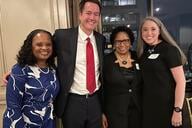You have /5 articles left.
Sign up for a free account or log in.
The concept of storytelling is everywhere. In every industry, marketers are trying to create stronger emotional connections with their audiences through stories. My institution is no exception.
One of my team’s goals is to tell better stories of our students, our alumni, our faculty, and our staff. As part of that, in partnership with mStoner, we launched a digital storytelling project to develop multimedia stories for use across our marketing initiatives. We started the project about a year ago, and as usually happens, we learned a lot. Here are six things we learned:
1. Create a timeline. Then double it.
Developing and publishing our first story took twice as long as we expected. As often happens with new initiatives, we had to push it aside several times to allow our team to work on more urgent projects. In the end, it took six months from our original brainstorming session to publish the first story.
2. Cast a wide net.
I’ve worked on three campuses, and in my experience, the most challenging part of storytelling is identifying the great stories. Faculty members and staff are busy, and thinking about marketing is our top priority, not theirs. So we regularly ask them for story ideas.
3. Get input from your whole team.
We have full team brainstorming sessions to identify potential student and alumni stories. We’ve found that our social media manager knew about students that others on the team weren’t aware of, and that one of our designers heard an interesting student story when she worked on the viewbook. Brainstorming as a team allows us to get all of the potential story subjects and angles into our database. And talking about all of the possibilities as a team allows us to get many viewpoints on shaping the story.
4. Pick the best stories, not the best students.
The students we most often hear about from faculty are the outstanding students who have had academic success and gotten great jobs — we are very proud of those students. But great stories have tension and drama, and times when things haven’t gone well. My favorite anecdote is from the student who planned on becoming a surgeon until he found out that he fainted at the sight of blood. That’s an interesting story. (To hear more, read the “Bryce” story linked below.)
5. Work on multiple stories at once.
Each story will develop at a different pace. Each story will have stops and starts. Just as your team is juggling projects, the people you’re profiling are dealing with multiple priorities. It’s important to work on multiple stories at a time so that you can keep moving forward. At the start of the project, we worked on two stories at a time. Based on that experience, we’re now working on four at a time.
6. Think about the template at the end.
In both cases, we developed the template — including the story length, photo and video placement — upfront, based on a very rough outline of the story. In both cases we started over once we had all of the assets, because the actual story didn’t fit our parameters. Going forward, we’ll let the story develop first, and then develop the template around it.
If you’d like to see the initial results of our project, read about Rebecca and Bryce.




